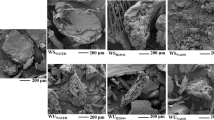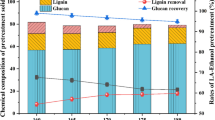Abstract
Microwave-assisted pretreatment can be used for fermentable sugar production from lignocellulosic biomass. In this study, the optimum hydrolysis conditions of barley husk, oat husk, wheat bran, and rye bran were determined in power level, treatment time, solid-to-liquid ratio and dilute acid ratio as follows: 700 W, 6.92 min, 1:18.26 w/v, and 3.67% for barley husk, 600 W, 6.96 min, 1:17.22 w/v, and 3.47% for oat husk, 600 W, 6.92 min, 1:16.69 w/v, and 1.85% for wheat bran, and 460 W, 6.15 min, 1:17.14 w/v, and 2.72% for rye bran. The fermentable sugar concentrations were 37.21 (0.68 g/g), 38.84 (0.67 g/g), 49.65 (0.83 g/g), and 36.27 g/L (0.62 g/g) under optimum conditions, respectively. The results showed that microwave-assisted pretreatment is a promising technology which can be successfully implemented for the hydrolysis of lignocellulosic biomass for high sugar yield. On the other hand, hydrolysates included some inhibitors such as organic acids, furans, and phenolic compounds. Lignocellulosic biomass used in this study can be employed as good feedstocks for value-added product production in the fermentation process, after the inhibitors have been detoxified/removed with different detoxification methods.


Similar content being viewed by others
References
Bledzki AK, Mamun AA, Volk J (2010) Barley husk and coconut shell reinforced polypropylene composites: the effect of fibre physical, chemical and surface properties. Compos Sci Technol 70:840–846
Chai T, Draxler RR (2014) Root mean square error (RMSE) or mean absolute error (MAE)?–Arguments against avoiding RMSE in the literature. Geosci Model Dev 7:1247–1250
Chaud LCS, Silva DDVd, Mattos RTd, Felipe MdGdA (2012) Evaluation of oat hull hemicellulosic hydrolysate fermentability employing Pichia stipitis. Braz Arch Biol Technol 55:771–777
Chen WH, Tu YJ, Sheen HK (2011) Distruption of sugarcane bagasse lignocellulose structure by means of dilute sulfuric acid pretreatment with microwave-assisted heating. Appl Energy 88:2726–2734
Chen WH, Ye SC, Sheen HK (2012) Hydrolysis characteristic of sugarcane bagasse pretreated by dilute acid solution in a microwve irridiation environment. Appl Energy 93:237–244
Cruz JM, Moldes AB, Bustos G, Torrado A, Domínguez JM (2007) Integral utilisation of barley husk for the production of food additives. J Sci Food Agric 87:1000–1008
Falck P, Aronsson A, Grey C, Stålbrand H, Karlsson EN, Adlercreutz P (2014) Production of arabinoxylan-oligosaccharide mixtures of varying composition from rye bran by a combination of process conditions and type of xylanase. Bioresour Technol 174:118–125
FAOSTAT (2016) http://faostat3.fao.org/download/Q/QC/E. Accessed 04.Aug.2016
Germec M et al (2016a) Ethanol production from rice hull using Pichia stipitis and optimization of acid pretreatment and detoxification processes. Biotechnol Prog 32(4):872–882
Germec M, Tarhan K, Yatmaz E, Tetik N, Karhan M, Demirci A, Turhan I (2016b) Ultrasound-assisted dilute acid hydrolysis of tea processing waste for production of fermentable sugar. Biotechnol Prog 32(2):393–403
Inan H, Turkay O, Akkiris C (2014) Microwave and microwave-alkali effect on barley straw for total sugar yield. Int J Glob Warm 6:212–221
Jacquemin L, Mogni A, Zeitoun R, Guinot C, Sablayrolles C, Saulnier L, Pontalier P-Y (2015) Comparison of different twin-screw extraction conditions for the production of arabinoxylans. Carbohydr Polym 116:86–94
Jiang S, Guo N, X-j Li (2016) The saccharification of destarched wheat bran with microwave-assisted acid treatment. Energy Sour A 38:209–213
Kajala I et al (2016) Rye bran as fermentation matrix boosts in situ dextran production by Weissella confusa compared to wheat bran. Appl Microbiol Biotechnol 100:3499–3510
Kamal-Eldin A et al (2009) Physical, microscopic and chemical characterisation of industrial rye and wheat brans from the Nordic countries. Food Nutr Res 53(1):1912. doi:10.3402/fnr.v53i0.1912
Köhnke T, Pujolras C, Roubroeks JP, Gatenholm P (2008) The effect of barley husk arabinoxylan adsorption on the properties of cellulose fibres. Cellulose 15:537–546
Kumar R, Tabatabaei M, Karimi K, Horvath IS (2016) Recent updates on lignocellulosic biomass derived ethanol-a review. Biofule Res J 9:347–356
Li S, Xu S, Liu S, Yang C, Lu Q (2004) Fast pyrolysis of biomass in free-fall reactor for hydrogen-rich gas. Fuel Process Technol 85:1201–1211
Li H, Qu Y, Yang Y, Chang S, Xu J (2016) Microwave irradiation–A green and efficient way to pretreat biomass. Bioresour Technol 199:34–41
Liu CZ, Cheng XY (2010) Improved hydrogen production via thermofilic fermentation of corn stover by microwave-assisted acid pretreatment. Int J Hydrog Energy 35:8945–8952
Loow Y-L, Wu TY, Jahim JM, Mohammad AW, Teoh WH (2016a) Typical conversion of lignocellulosic biomass into reducing sugars using dilute acid hydrolysis and alkaline pretreatment. Cellulose 23:1491–1520
Loow Y-L, Wu TY, Yang GH, Jahim JM, Teoh WH, Mohammad AW (2016b) Role of energy irradiation in aiding pretreatment of lignocellulosic biomass for improving reducing sugar recovery. Cellulose 23:2761–2789
Miller GL (1959) Use of dinitrosalicylic acid reagent for determination of reducing sugar. Anal Chem 31:426–428
Mussatto SI, Roberto IC (2004) Alternatives for detoxification of diluted-acid lignocellulosic hydrolyzates for use in fermentative processes: a review. Bioresour Technol 93:1–10
Palmarola-Adrados B, Galbe M, Zacchi G (2005) Pretreatment of barley husk for bioethanol production. J Chem Technol Biotechnol 80:85–91
Pienkos PT, Zhang M (2009) Role of pretreatment and conditioning processes on toxicity of lignocellulosic biomass hydrolysates. Cellulose 16:743–762
Ravindran R, Jaiswal AK (2016) A comprehensive review on pre-treatment strategy for lignocellulosic food industry waste: challenges and opportunities. Bioresour Technol 199:92–102
Ruiling S, Jilin D, Zhangcun W (2006) The study of the microwave-assisted extraction of naked oat bran β-glucan. Chin Agric Sci Bull 10:075
Serna-Saldivar SO (2016) Cereal grains: properties, processing, and nutritional attributes, chap 1. CRC, Baca Raton, FL, pp 4–7
Singh R, Shukla A, Tiwari S, Srivastava M (2014) A review on delignification of lignocellulosic biomass for enhancement of ethanol production potential. Renew Sustain Energy Rev 32:713–728
Singleton VL, Orthofer R, Lamuela-Raventos RM (1999) Analysis of total phenols and other oxidation substrates and antioxidants by means of folin-ciocalteu reagent. Methods Enzymol 299:152–178
Sipponen MH, Pastinen OA, Strengell R, Hyötyläinen JM, Heiskanen IT, Laakso S (2010) Increased water resistance of CTMP fibers by oat (Avena sativa L.) husk lignin. Biomacromolecules 11:3511–3518
Sluiter A et al. (2008) Determination of total solids in biomass and total dissolved solids in liquid process samples. National Renewable Energy Laboratory Technical Report No. NREL/TP-510-42621:1–6
Wang W, Klopfenstein C (1993) Effect of twin-screw extrusion on the nutritional quality of wheat, barley, and oats. Cereal Chem 70(6):712–715
Welch RW, Hayward MV, Jones DIH (1983) The composition of oat husk and its variation due to genetic and other factors. J Sci Food Agric 34:417–426
Wood IP, Cook NM, Wilson DR, Ryden P, Robertson JA, Waldron KW (2016) Ethanol from a biorefinery waste stream: saccharification of amylase, protease and xylanase treated wheat bran. Food Chem 198:125–131
Zhang Z, Vancov V, Mackintosh S, Basu B, Lali A, Qian G, Hubson P, Doherty WOS (2016) Assesing dilute acid pretreatment of different lignocellulosic biomasses for enhanced sugar production. Cellulose 23:3771–3783
Acknowldgments
This study was supported by the Akdeniz University Research Foundation.
Author information
Authors and Affiliations
Corresponding author
Rights and permissions
About this article
Cite this article
Germec, M., Demirel, F., Tas, N. et al. Microwave-assisted dilute acid pretreatment of different agricultural bioresources for fermentable sugar production. Cellulose 24, 4337–4353 (2017). https://doi.org/10.1007/s10570-017-1408-5
Received:
Accepted:
Published:
Issue Date:
DOI: https://doi.org/10.1007/s10570-017-1408-5




